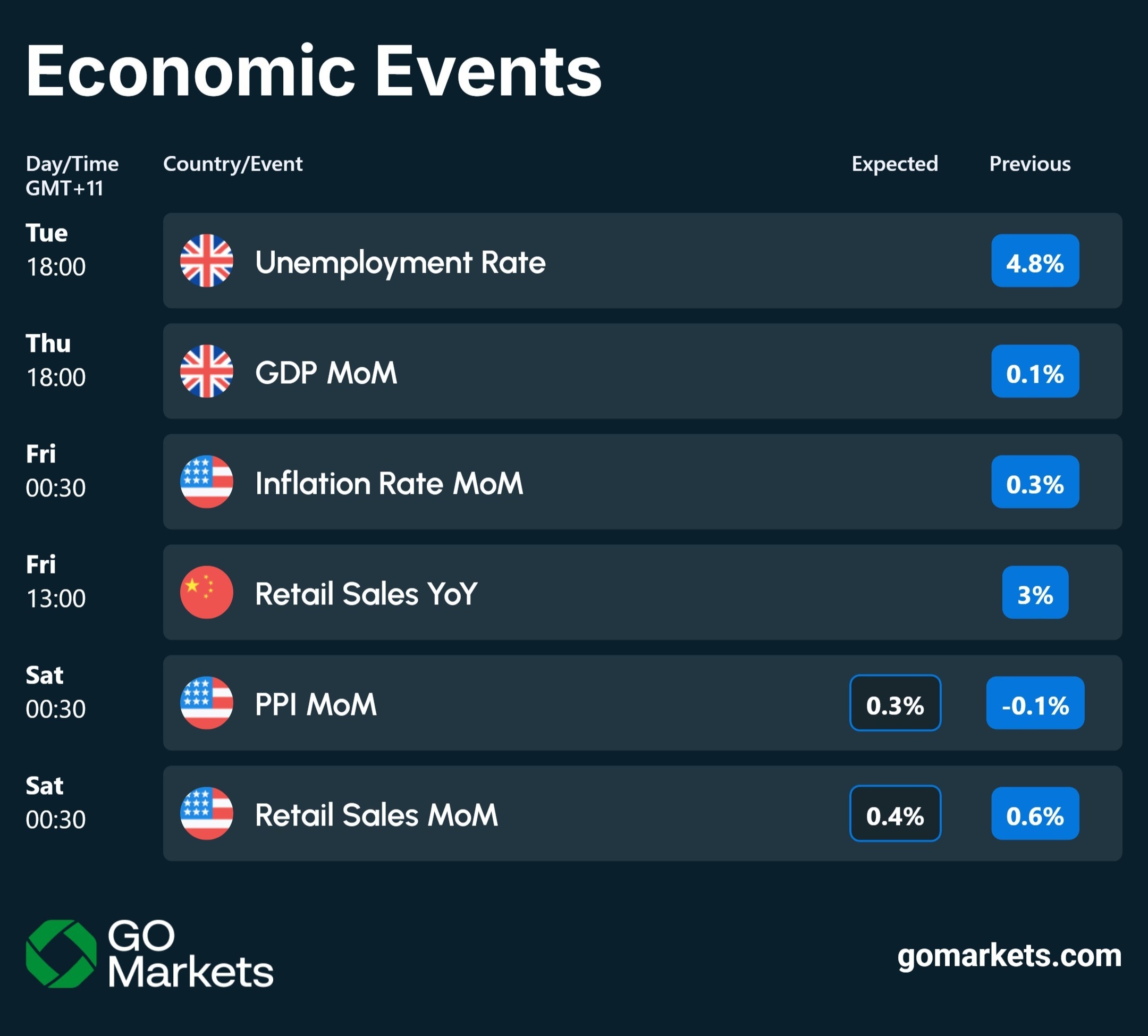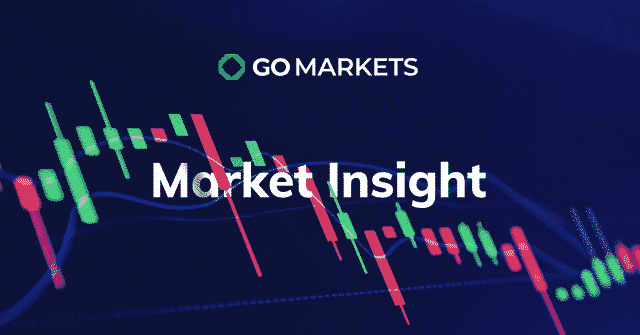Berita & analisis pasar
Tetap selangkah lebih maju di pasar dengan wawasan ahli, berita, dan analisis teknikal untuk memandu keputusan trading Anda.

Markets retreated last week, pulling back about 2.5-3% from record levels. While the decline is modest, it is marked by several headwinds that could create further pressure this week.
Government Shutdown Reaches Historic Length
The ongoing shutdown has now reached record duration, and there's still no clear resolution in sight. Healthcare remains the primary sticking point between the two sides. Some reports suggest potential progress, but the jury's still out on whether any deal will materialise or gain bipartisan support before the Thanksgiving holiday season.
Key Economic Data May Be Delayed
The shutdown's impact extends to data releases. Market-influencing government reports, including jobs numbers and CPI data, may be delayed this week — CPI is still technically scheduled, but the shutdown could affect its release. This data delay will make it harder to gauge the economy's true direction and could inject further volatility into markets.
Earnings Season Continues to Impress
Despite these macro headwinds, corporate America is delivering exceptional results. We're seeing an 82% EPS beat rate and 77% of companies exceeding revenue expectations. While we're in the final 10% of S&P 500 reports, some important retail stocks are still due. These consumer-facing companies could provide valuable insights into spending patterns and economic health.
NVIDIA Tests Critical Support Level
AI stocks are facing pressure, with NVIDIA testing a key technical level around $180-$185. The stock experienced five consecutive days of losses before bouncing strongly on Friday with a major wick rejection. If support at $180 breaks, we could see a drop to $165. However, Friday's bounce suggests a possible retest of $193. This is a crucial moment for the AI sector leader, and its direction could influence broader tech sentiment.
Market Insights
Watch the latest video from Mike Smith for the week ahead in markets.
Key economic events
Keep up to date with the upcoming economic events for the week.



Netflix reported their Q1 earnings after the closing bell on Tuesday. The online streaming service reported total revenue of $7.16 billion in Q1 beating analyst forecast of $5.77 billion. Earnings per share were reported at $3.75 vs. $2.98 estimate.
With both revenue and earnings per share higher than analysts' expectations, the new paid subscriber additions came in way below analysts' forecast of 6.29 million – at 3.98 million. The latest dip in new additions could be the beginning of a further slowdown in new subscribers as lockdown eases around the world and people return to normality. ''Revenue grew 24% year over year and was in line with our beginning of quarter forecast while operating profit and margin reached all-time highs. We finished Q1’21 with 208m paid memberships, up 14% year over year, but below our guidance forecast of 210m paid memberships.
We believe paid membership growth slowed due to the big Covid-19 pull forward in 2020 and a lighter content slate in the first half of this year, due to Covid-19 production delays. We continue to anticipate a strong second half with the return of new seasons of some of our biggest hits and an exciting film lineup. In the short-term, there is some uncertainty from Covid-19; in the long-term, the rise of streaming to replace linear TV around the world is the clear trend in entertainment,'' Netflix said in a letter to investors following the announcement.
Shares of Netflix was down by around 9% in post-market on Tuesday following the latest numbers, down at $495 per share after ending the trading day a $549.57 per share. Netflix Source: TradingView You can trade Netflix (NFLX) and many other stocks from the NYSE, NASDAQ and the ASX with GO Markets as a Share CFD. Click here for more information.
Trading Derivatives carries a high level of risk.


Last week marked a significant milestone for NIO when it produced its 100,000 th electric vehicle. The latest development also caught the eye of Tesla CEO Elon Musk, to which he responded: ''Congrats to NIO. That is a tough milestone.'' On Thursday, NIO officially confirmed its partnership with Sinopec – taking a major step forward in the company’s future.
Rumours about a potential partnership between the two companies first emerged back in February, when Sinopec Chairman Zhang Yuzhuo visited NIO’s battery swap station. About Sinopec Sinopec is the largest supplier of refined oil products and petrochemicals as well as the second-largest oil and gas producer in China. It was founded on 25 th February 2000 in Beijing, China and has over 240,000 employees globally.
The company has more than 30,000 gas stations – second highest in the world. The partnership NIO’s statement on the partnership: ''The partnership between Sinopec and NIO is an important milestone for further developing China's smart EV industry, a concrete measure to help achieve peak carbon emissions and achieve carbon neutrality, a key step in developing global, green, and innovative transportation initiatives and innovations.'' Following the announcement, NIO and Sinopec also unveiled the NIO Power Swap Station 2.0 at Sinopec's Chaoying Station in Beijing, China. The share price of NIO has taken a hit in recent months after reaching record highs back in February when it climbed above $60 per share.
It was down by around 5% on Thursday following the announcement, trading at around $34 per share. Worth noting that it was trading at $3.20 per share same time last year, a 995% increase at the current share price. NIO Source: TradingView You can trade NIO (NIO) and many other stocks from the ASX, NYSE, and the NASDAQ with GO Markets as a Share CFD.
Click here for more information. Trading Derivatives carries a high level of risk.


JPMorgan and Goldman Sachs reported their Q1 earnings before the opening bell on Wednesday – both beating analysts' forecasts. JP Morgan & Co JPMorgan reported a total revenue of $32.3 billion (up by 14.3% year-on-year) in Q1, above analysts' forecast of $30.52 billion. Earnings per share were reported at $4.50 vs. $3.05 estimate.
Jamie Dimon, Chairman and CEO, commented on Q1 results: ''JPMorgan Chase earned $14.3 billion in net income reflecting strong underlying performance across our businesses, partially driven by a rapidly improving economy. These results include a benefit from credit reserve releases of $5.2 billion that we do not consider core or recurring profits. We believe our credit reserves of $26 billion are appropriate and prudent, all things considered.'' ''With all of the stimulus spending, potential infrastructure spending, continued Quantitative Easing, strong consumer and business balance sheets and euphoria around the potential end of the pandemic, we believe that the economy has the potential to have extremely robust, multi-year growth.
This growth can benefit all Americans, particularly those who suffered the most during this pandemic. If all of the government programs are spent wisely and efficiently, focusing on actual outcomes, the benefits will be more widely shared, economic growth will be more sustainable and future problems, like inflation and too much debt, will be reduced.'' Shares of JPMorgan were down by around 1.19% in pre-market on Wednesday following the latest earnings numbers, trading at around $152.23. The share price is up by around 22% year-to-date.
JPMorgan Chase & Co Source: TradingView Goldman Sachs Goldman Sachs also reported strong numbers with revenue of $17.7 billion (up by 102.5% year-on-year) in Q1, way higher than analysts' estimate of $12.6 billion. Earnings per share at $18.60, above the forecast of $10.22 per share. ''We have been working hard alongside our clients in preparation for a world beyond the pandemic and a more stable economic environment,'' Goldman Sachs CEO, David Solomon said in the earnings release. ''Our businesses remain very well positioned to help our clients reposition for the recovery, and that strength is reflected in the record revenues and earnings achieved this quarter.'' Goldman Sachs The share price of Goldman Sachs trading higher after the Q1 results, up by around 4% at $343 per share. The stock is up by 30% year-to-date.
Source: TradingView You can trade JPMorgan Chase & Co (JPM), Goldman Sachs (GS) and many other stocks from the NYSE, NASDAQ and the ASX with GO Markets as a Share CFD. Click here for more information. Trading Derivatives carries a high level of risk.


The traditional relationship between equity markets and forex is complex and often not particularly well correlated. As a result company earnings are often of little interest to Forex traders. However, this earnings season may be different.
Theoretically, if a country’s equity markets perform well, as the US market has done year to date, then this creates confidence, attracts foreign investors and results in demand for the local currency (and of course vice versa). Companies in the US report quarterly (unlike Australia where most report 6 monthly), and most of these reports are released within a 2-3 week timeframe creating a so called ‘earnings season’. There is no time that influences equity market sentiment and share pricing more than this.
So, logically US earnings season may generally influence USD pairs. However, this earnings season, which started last week, may have additional significance beyond the norm. Clearly one of the major market areas of interest is the “will they-wont they” debates about whether the US Federal reserve will cut interest rates when it meets next.
Under normal market conditions the “Fed” primarily considers jobs data and inflation (CPI) in its decision-making relating to interest rate decisions. However, with the latest job numbers beating expectations significantly together with concerns from trade wars, Chinese growth slow down and European weakness, they are looking beyond the more traditional “measures” to determine when, and by how much, any rate cut is merited. A strong company earnings season in the US (both in terms of revenue and projected performance) may now be part of the equation to fulfil their mandate.
Of course, this goes beyond the performance of individual companies, rather a broad measure of hits/misses both retrospectively and prospectively is what may become part of their decision-making. The relationship between interest rate decisions and currency movements is obvious to all, hence with the potential part that earnings reports may play in such a decision, this time makes this season of great interest. It is worth pointing out that the reason for developing awareness of this is not to encourage prediction of what the Fed may do, rather to suggest that this awareness may help in terms of identifying potential risks to what the market has or has not already priced in to currency pairs.
We will be discussing the interplay of information and how it may influence all financial instruments in the next Inner Circle session. It would be great to see you there on the LIVE webinar. Find out more by clicking here


Market response to any specific economic data release is far from standard even if actual numbers differ greatly from consensus expectations. Rather the market response is based on context of the current economic situation. This week’s non-farm payrolls, being one of the major data points in the month, is a great case in point.
There are many factors and of course the key one for you as an individual trader is your chosen vehicle you are trading (and of course direction i.e. long or short for open positions). The context of today’s impending non-farm payrolls from a market perspective is interest rate expectations going forward. This week the Fed gave the market the expected.25% cut that was already priced into currency, bond and equity market pricing.
The market response however, as this was already priced in, was as a result of the accompanying statement which was not as dovish as perhaps anticipated and a reduction in expectations of a further imminent cut. From an equity market point of view the result, despite the interest rate cut, was to sell off, whereas from the USD perspective this lessening expectation of further rate cuts was bullish. Perhaps this could be viewed as contrary to what the textbooks would suggest is a standard response.
So, onto todays non-farm payrolls (NFP) figure… Logic would suggest that a strong number is good news for the economy, and so should be positive for equities and perhaps bearish for USD. However, as this may be a critical number in the Feds decision making re. interest rate decisions, a strong NFP is likely to have the opposite effect. A weaker number is likely to be perceived as potentially contributory to thinking that another rate cut may be prudent sooner and so despite on the surface being “bad news”, it would not be surprising to see equities stronger and USD weaker.
It remains to be seen of course what the number is and the actual response but is perhaps a lesson in seeing new market information within the potential context of the current economic circumstances and of course incorporate this in your risk assessment and trading decision making.


In the midst of Wednesday afternoon's global bond sell-off, we saw government bond yields rise across the board and in one particular 10-year bond we saw a significant level approached and then surpassed. Japanese Government Bond – 10-year yield The Japanese government's 10-year bond yield rose to and then surpassed 0.145 percent, a significant level because the Japanese government has kept pretty tight control over treasury yields. Last time yields approached this level we saw a spur in BoJ (Bank of Japan) bond buying.
However, to keep yields lower, we are yet to see such action from the BOJ this time. It could be down to the current perceived weakness in the Yen currency which could be affording central banker's the breathing room to hold off on further bond purchasing. However, this may not be just some temporary blip in bond/yield prices, and this may be the beginning of a shift in the BoJ's approach to monetary policy.
Up until this point, Governor Kuroda was seemingly happy with allowing the Yen's price to slide versus the dollar to help revive Japan's economy. However, chief economist at Mizuho Bank in Tokyo, Daisuke Karakama, recently said: " Foreign-exchange markets see the excessively one-sided rise in the dollar-yen as hurting bilateral trade negotiations, and that’s spurring speculation that Japan will take some action." USDJPY – Daily Chart Donald Trump recently levelled accusations of currency manipulation at both China and Europe, in an effort to avoid having similar accusations laid at their feet the BoJ may have already begun attempting to stem the slide in the yen vs. the dollar so as to allow trade talks to take place more smoothly and gain access to the U.S. markets. Tatsuhiro Iwashige, Tokyo based GCI Asset Management chief FX strategist, recently commented that the moves to stop the yen's decline could be " extremely simple " and may potentially come from local bond yields being higher than what they are.
The Yen has seen speculative strengthening before on the back of potential BoJ monetary policy changes, a 3% jump after the bank cut bond purchases. Could the BoJ's reluctance to step in where they have previously with the 10-year yield be a sign that we are about to see a strengthening in the Yen? The market has concerns around the 115 level prompting some level of intervention. “Kuroda has that power and markets are wary," Tatsuhiro Iwashige also commented, "Kuroda must be careful about the timing, thanks to the experience of what happened in 2015, but 120 will prompt him to come to the fore.” Whether it comes sooner or at the 120 print from USD/JPY, it seems clear that to remain competitive in regards to trade talks with the U.S. it appears that Governor Kuroda and the BoJ will have to make a shift in monetary policy. @ AlexS_Trading This article is written by a GO Markets Analyst and is based on their independent analysis.
They remain fully responsible for the views expressed as well as any remaining error or omissions. Trading Forex and Derivatives carries a high level of risk. Sources: Bloomberg

